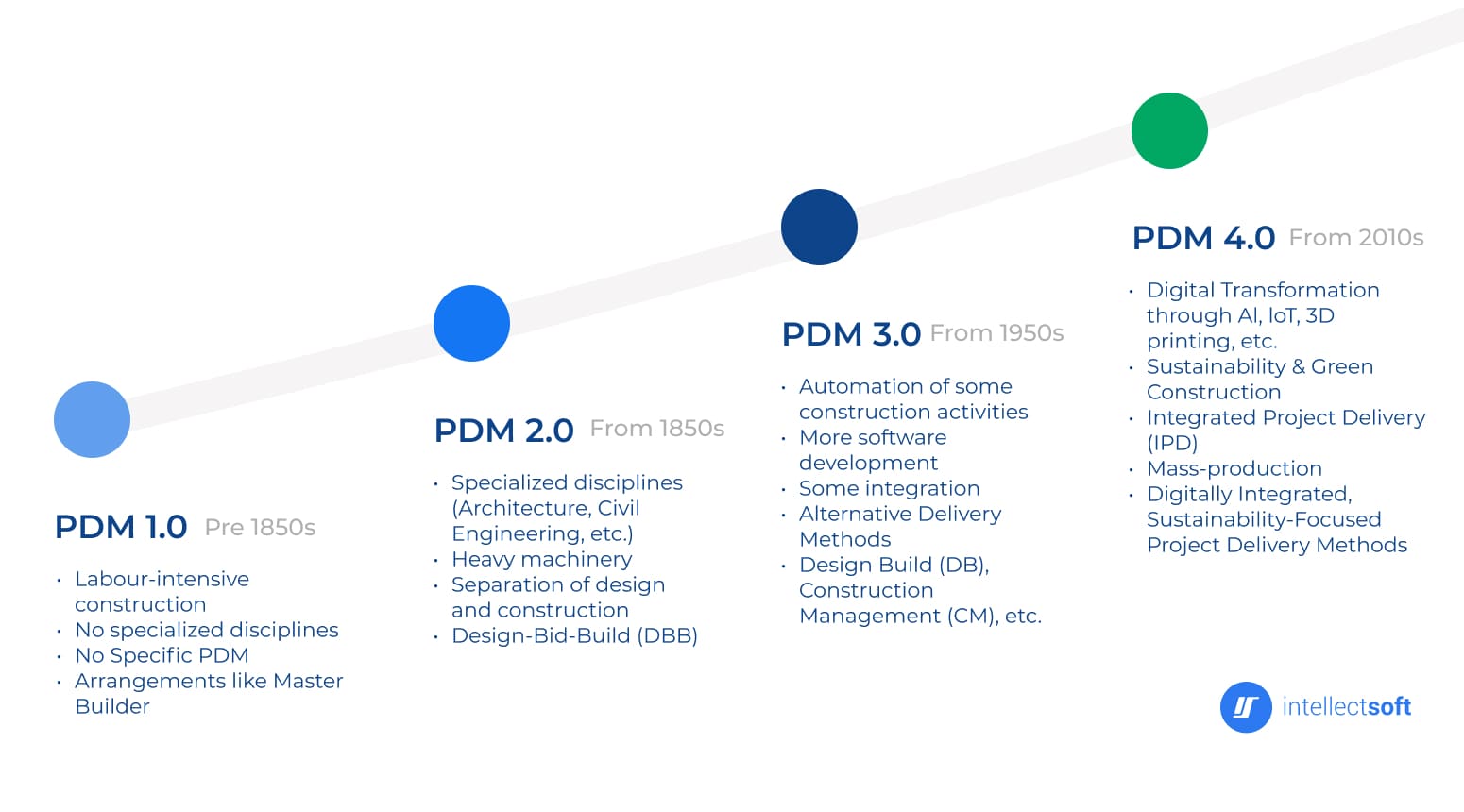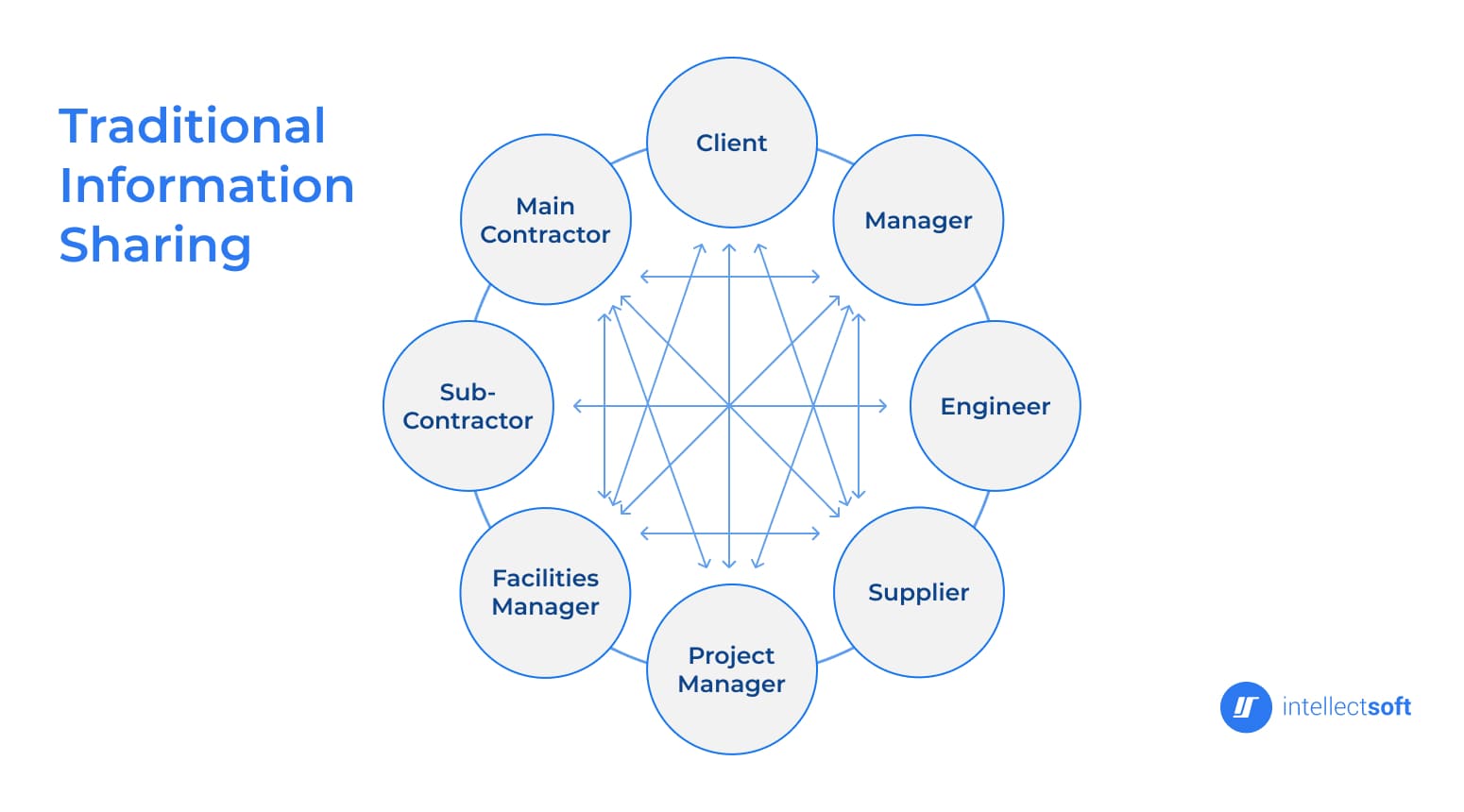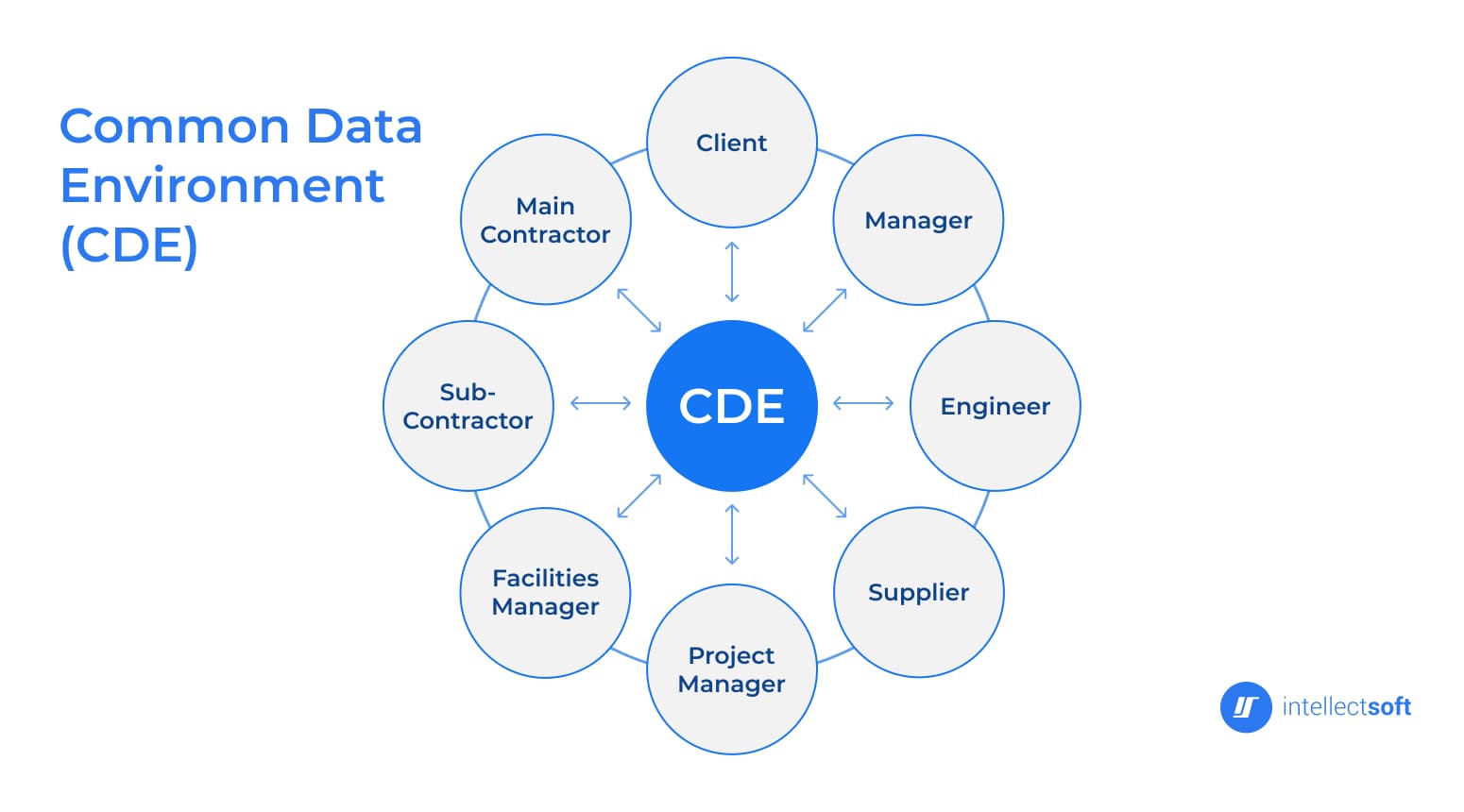If you’re involved in the construction industry, you likely know the struggles of dealing with sketchy information and the challenges that come with it. Inefficient management, poor decision-making, cost overruns, delays—and we’re naming just a few. On the sunny side, modern times bring modern solutions, and digital data analytic tools have become an essential segment of the industry. Enters common data environment (CDE).
Going digital in the construction world stretches way beyond the convenience of using the latest gadgets. Common data environment and BIM technologies are transforming the entire landscape to make things as clear and streamlined as possible. And let’s not forget about teamwork: construction projects involve a powerful workforce. Architects, engineers, and builders all need to share information with each other. The frequency of exchange, back and forth, creates an ever-evolving dynamic data landscape as the project goes on, requiring an equally powerful system for organizing all the data available.
In simple (also not overenthusiastic) words, the common data environment is a game-changer. It helps construction jobs run more smoothly and accurately, leading to fewer delays and staying on budget. The question is: how?
We will now dive deep into how a CDE works, what good stuff it brings to the table, and how it's really making a difference in building stuff today.
What is a Common Data Environment (CDE)?
The name refers to a digital, cloud-based platform designed specifically for construction projects. At its core, it’s a giant database that stores all relevant information, making it accessible and handy to all project participants—but that's not all. As a central hub for accumulating, managing, and sharing project data, common data environments are sophisticated ecosystems that allow complex interaction while keeping all necessary details at your fingertips, regardless of physical location.
The market demand behind the common data environment’s existence is pretty clear. Taking predictions by Oxford Economics into account, we can expect the need for effective data management in construction to grow in geometric progression. During the next 15 years, global construction work will grow from US$9.7 trillion in 2022 to US$13.9 trillion in 2037. Expectedly, the market is driven by superpower construction markets China, the US, and India.
But How Exactly Does the CDE Fit Into That Picture?
In the old days, construction projects would easily get tangled up in misunderstandings and mix-ups with paperwork. Even though software solutions have been gradually developed since the mid-20th century, until recently, project managers had to rely on the manual processing of fragmented systems, where the results could easily get off track. The deficiency of comprehensive information sometimes induced such negative outcomes as poor data management followed by problematic, intuition-based decisions.

These time-consuming processes also hindered project success in other ways. Difficulties in accurately predicting and managing budgets and timelines led to cost overruns, inconsistent quality, and expensive delays. Communication gaps among multiple stakeholders were unavoidable, resulting in errors, misunderstandings, and inadequate risk management. And challenges in ensuring compliance with various, ever-changing regulations just added to the pile.
This is where the common data environment excels, taking the role of a superpowered digital meeting room.
CDE in construction is revolutionizing the industry by tackling its core challenges. It streamlines data management, replacing manual and disjointed processes with quick, efficient systems. It also enhances decision-making by providing accurate, real-time data for informed choices, preventing costly mistakes and project delays. Furthermore, it addresses communication gaps, ensures quality control, manages risks effectively, and aids in maintaining regulatory compliance.
The Building Blocks of CDE
According to the ISO 19650 standard, two integral parts of the BIM-based execution of construction projects involve project management and information delivery. Project management comprises all steps necessary to set up a BIM project, from Employer Information Requirements (EIR) to the preparation of the BIM Execution Plan (BEP).
Information delivery, on the other hand, is about model creation, which is heavily related to the Common Data Environment (CDE).
Data Integration in CDE
Data integration is a key functionality of common data environments, converging diverse sources and formats into a single, coherent system. This synthesis maintains the continuity and integrity of project data, ensuring that all stakeholders work with the most current and accurate information.
Example: An architect's blueprints combined with an engineer's technical specs make the design plan as a whole more understandable for everyone.
Collaboration Tools in CDE
A common data environment is equipped with a range of collaborative tools designed to facilitate communication and teamwork. These tools enable document sharing, version control, and real-time chat functions, among others, enhancing the cooperative spirit of construction projects.
Example: A builder spots an issue on-site. They immediately share a photo in the CDE, and the architect can promptly respond with revised plans. Managers and supervisors automatically get informed on the changes and what caused them, all at the same time and within the same system.
Data Security and Access Control In CDE
Data security is a critical component of common data environments in an industry where sensitive and confidential information is frequently exchanged. The system addresses this concern by implementing robust access control mechanisms, ensuring only authorized personnel can access selected project data. Such an approach protects sensitive information and fosters a sense of trust among project participants at the same time.
Example: A construction project for a government building with strict security requirements. In the CDE, access to detailed security system plans and confidential contract documents can be restricted to only a few key personnel, such as the lead architect, the project manager, and the government liaison. At the same time, it still allows a broader construction team access to general timelines or material lists.
Practical Applications of CDE

Streamlining Workflows
One of the primary advantages of a common data environment is its ability to streamline project workflows. By creating a unified data management and communication platform, CDEs diminish redundancy and inefficiency, leading to smoother overall execution in return.

This asset is particularly beneficial in large infrastructure projects, such as the construction of highways or bridges, where a common data environment significantly reduces the time spent on data entry and verification. In addition, the streamlined approach saves time and reduces the likelihood of errors.
Key benefit: The centralized approach of CDE in construction allows for a more coordinated and coherent workflow, reducing the time and effort typically associated with data management.
Enhancing Collaboration Through CDE
Common data environments have been instrumental in enhancing collaboration in construction projects. By providing a common platform for information exchange, they enable seamless coordination among diverse project stakeholders.
This feature offers a notable advantage in constructing high-rise buildings, where architects, engineers, contractors, and clients need simultaneous access to the project's data pool. Real-time collaboration leads to a more dynamic, interactive project environment, where changes and updates are communicated instantly, significantly improving the outcomes.
Key benefit: Improved collaboration leads to a more integrated project approach, where decisions are made efficiently and project goals are achieved more effectively.
Informed Decision-Making via CDE
CDEs enable access to real-time, comprehensive data, which is crucial for informed decision-making.
In residential construction projects, for instance, project managers leverage CDEs to monitor progress, resource allocation, and budgetary constraints. The real-time overview enables them to make quick, informed decisions, adjust strategies promptly, and mitigate risks effectively.
Key benefit: Informed decision-making allows project managers and stakeholders to act on the most current and complete information available, leading to more effective administration and better overall outcomes.
Implementing CDE in Construction Sector
While the benefits of a common data environment are clear, its implementation in the construction industry is not free of challenges. Common obstacles include the technological learning curve, resistance from staff accustomed to traditional methods, and the need for integration with existing systems. To successfully implement a CDE, it's essential to address these issues head-on.
Discussions at forums like the European BIM Summit have highlighted the importance of standardized implementation methods that can unify the approach. This emphasizes the need for a cohesive strategy to encourage the adoption process in line with the global best practices across the industry.
Overcoming Implementation Challenges
Managing resistance to change is one of the main challenges of implementing CDE in construction. It requires clear communication about the benefits of CDE and how it simplifies tasks, along with highlighting its role in reducing errors and saving time.
Integrating disparate data sources into a common data environment is another common issue. To tackle this, start with a comprehensive audit of existing data and systems. Utilize specialized integration tools or services to streamline this process, ensuring a smooth transition.
Finally, adequate training and support are critical for successful implementation. Offer extensive training sessions and continuous support to ensure all users are comfortable and proficient with the new system.
Best Practices for Data Management in CDE
Effective data management within a CDE involves the quality and accuracy of data, clear governance protocols, and system maintenance that will ensure its ongoing efficacy.
Key practices include:
- Regular data audits
- Clear documentation of processes
- Training all users on best data management practices
Case Studies and Success Stories
The case study conducted in Checz Republic is a comprehensive example of streamlining workflows with a common data environment in construction. It examines the remodeling of the As-Built documentation into the BIM and GIS environment during the railway construction project, specifically focusing on the Šumice railway station.
The key aspects of the study include the transformation of documentation into a BIM/GIS-based common data environment, the challenges and solutions associated with this transition, as well as its benefits. The conversion from CAD to BIM CDE is generally found automatable at about 65%, leaving 35% to human decision-making.
Emphasizing the shift from traditional 3D CAD (Computer-Aided Design) documentation to a common BIM (Building Information Modeling) or GIS (Geographic Information Systems) data environment, the authors found that the use of documentation was particularly efficient during the operational phase of the construction, including tasks like maintenance planning.
The study acknowledges that current software systems can still have limitations in capturing geometric shapes with absolute accuracy. Despite these challenges, the authors found satisfactory solutions within the existing applications.
Their conclusion is that converting original CAD documentation into BIM significantly streamlines approval processes during construction preparation and execution. The data generated by BIM-managed software was also beneficial for other miscellaneous engineering and administrative purposes.
Future Trends in CDE
The future of common data environment in construction is shaped by emerging technologies such as artificial intelligence (AI), machine learning, and the Internet of Things (IoT).
These technologies promise to enhance the capabilities of CDEs, offering more advanced data analytics, predictive modeling, and automation features. As the digital landscape continues to evolve, the role and impact of CDEs in the construction industry are expected to grow, further revolutionizing project management and execution.
Wrapping Up
The common data environment brings compelling digital change to the construction industry. It helps manage data, improve teamwork, and make better decisions, promoting successful outcomes of diverse construction projects.
Companies like Intellectsoft take great pride in delivering sophisticated common data environment solutions, drawing on the broad international expertise in the field. As a dedicated provider of CDE and BIM platforms, Intellectsoft ensures comprehensive support at every phase, from initial planning and discovery stages to ongoing assistance.
FAQ
What is CDE in construction?
CDE in construction refers to a centralized digital platform that manages, stores, and shares project information.
What is the difference between traditional data management methods and using a CDE in construction?
While traditional methods rely on separate, manual data management, a CDE centralizes and digitizes all data available, improving efficiency and cooperation inside the project.
How does a common data environment enhance BIM?
A common data environment provides a platform for BIM data management and collaboration, leading to more accurate and successful project execution.
Can CDEs be integrated with existing project management tools in construction?
Yes, common data environment solutions in construction are designed for compatibility. Integration with existing tools typically involves technical assistance and a well-planned strategy to ensure a successful outcome.